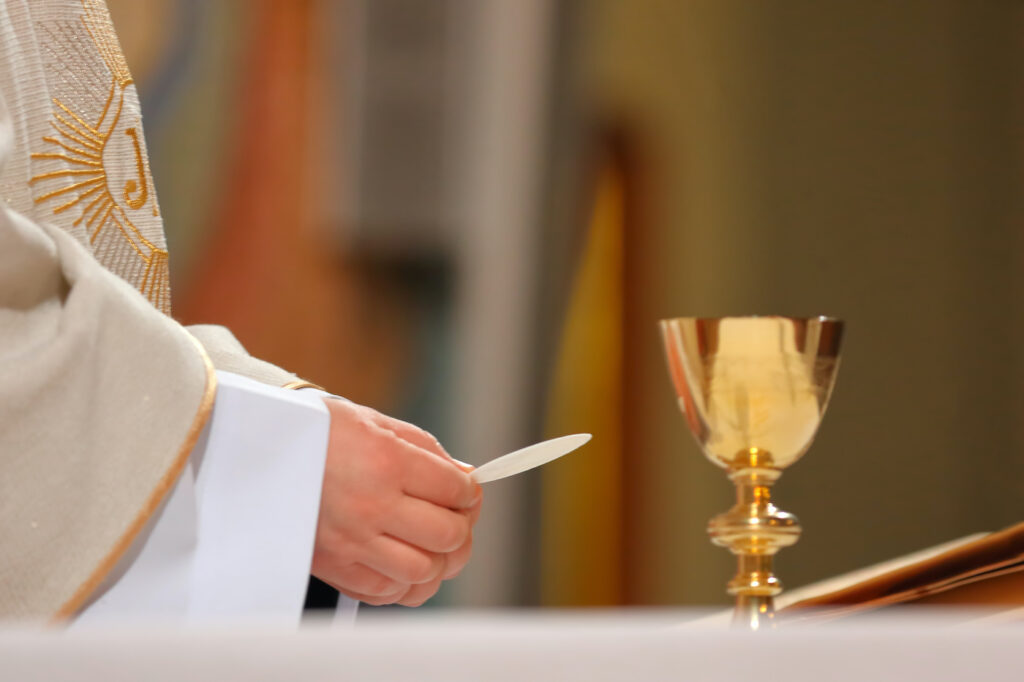I was thinking about Julia Flyte as I read the recent essay by Cardinal Robert McElroy in America. Lady Julia is a central character in Evelyn Waugh’s novel Brideshead Revisited. Married to a divorcé, and living out of wedlock with Charles Ryder, she has a near breakdown late in the novel when her callous brother explains why he cannot bring his fiancée Beryl to Julia’s house: “It is a matter of indifference whether you choose to live in sin with Rex or Charles or both—I have always avoided enquiry into the details of your ménage—but in no case would Beryl consent to be your guest.”
Julia’s response is powerful for expressing her awareness that, as much of an ass as Bridey might be, “He’s quite right. . . . He means just what it says in black and white. Living in sin, with sin, by sin, for sin, every hour, every day, year in, year out. Waking up with sin in the morning, seeing the curtains drawn on sin, bathing in it, dressing it, clipping diamonds to it, feeding it, showing it around, giving it a good time, putting it to sleep at night with a tablet of Dial if it’s fretful.”
This confession anticipates her final conversion of heart as her father is dying, a conversion that Charles could see coming “all this year,” and portending the end of his relationship with Julia.
Structures of Exclusion?
Start your day with Public Discourse
Sign up and get our daily essays sent straight to your inbox.I’ll come back to Waugh, who in 1947 wrote a penetrating analysis of Brideshead for MGM, which was thinking of making a filmed version of the story. But first to Cardinal McElroy. The central concern of his essay is with the “structures and cultures of exclusion that alienate all too many from the church or make their journey in the Catholic faith tremendously burdensome.” Much of what he says of these exclusions will strike most Catholics as reasonable: certainly the poor, racial minorities, the incarcerated, and the disabled have all, in various ways and at various times, been marginalized in unacceptable ways. The cardinal also notes that the “church at times marginalizes victims of clergy sexual abuse in a series of destructive and enduring ways.”
What does it mean to speak of “structures and cultures of exclusion” in these contexts? The meaning will vary from case to case, but it is worth spending a moment on the last mentioned. For one might judge that in, for example, the case of Fr. Marko Rupnik, structures and cultures of opacity, secrecy, prestige, lack of concern for procedural justice, and the marginalization of women religious contributed to an egregious series of harms and a remarkable (and repulsive) valorization of the man who perpetrated those harms. Catholics might indeed hope that the institutional structures and culture that made such abuse possible over so many years will be the object of serious scrutiny and reform among the members of the hierarchy.
More surprising, and controversial, is the turn Cardinal McElroy makes late in his essay in a discussion of “exclusion” of those whose lives are discordant with the Church’s sexual teachings. Discussing those “who are marginalized because circumstances in their own lives are experienced as impediments to full participation in the life of the church,” the cardinal notes that these “include those who are divorced and remarried without a declaration of nullity from the church, members of the L.G.B.T. community and those who are civilly married but have not been married in the church.”
Cardinal McElroy is not, as he makes clear, discussing those who, having remarried, now live chastely, or those who, experiencing sexual desires or orientation toward acts at odds with Church teaching, live in continence. Rather, his concern is with those who because of their acts are “excluded” from the reception of the Eucharist. That, he argues, is at odds with the Church’s witness to “radical inclusion and acceptance,” which cannot be predicated on a “distinction between orientation and activity.”
It is unclear how human persons could know what they do of God and His relationship to human persons if they did not understand marriage and its potential for bringing forth new life, if they did not understand the norms of exclusivity and fidelity that flow from marriage, or the norms that exclude all sexual activity outside marriage.
Cardinal McElroy’s arguments on this point are worth more sustained consideration than I can give them here, but the four substantive points he makes seem to me mistaken or distorted in their emphasis. I will work backward, since it is the first that I want to focus particularly on, through a brief discussion of Waugh’s memo.
The fourth of the cardinal’s points is that sexual activity is not at the heart of the hierarchy of Christian truths. This claim is not, however, unqualifiedly true, since marriage is the central sacramental image in the New Testament of the relationship of Christ to His Church; it is likewise the central image in the Old Testament of the relationship of God to His chosen people. And again, marriage is a prominent scriptural image of the Kingdom of Heaven, which is to be like a marriage banquet. This imagery teaches: it is unclear how human persons could know what they do of God and His relationship to human persons if they did not understand marriage and its potential for bringing forth new life, if they did not understand the norms of exclusivity and fidelity that flow from marriage, or the norms that exclude all sexual activity outside marriage.
The third claim is essentially a restatement of the very view that Cardinal McElroy is defending: that Eucharistic inclusiveness, rather than Eucharistic coherence, should be the guiding pastoral norm for the Church. But he gives little to no attention to the opposing view, that, in Pope Francis’s words, “This is not a penalty: you are outside. Communion is to unite the community.” But, the cardinal might respond, is this not a putting of the excluded outside the community? Could he or she not be invited in?
The short answer to the first of these questions is negative: central to the Church’s teaching about sin is that it involves a self-separation of the sinner from God and His Church. The problem, which McElroy’s essay invites us to ponder, is how this claim can be squared with the appropriate answer to the second question: “Could he or she not be invited in?” For the answer to that is an unhesitating “yes,” a yes that, we will see, is central to Waugh’s understanding of Brideshead.
The cardinal also, in making this claim about Eucharistic inclusion, makes reference to Pope Francis’s Gaudete et Exultate: “grace, precisely because it builds on nature, does not make us superhuman all at once. . . . Grace acts in history; ordinarily it takes hold of us and transforms us progressively.” Perhaps then the demands of Christian morality are too burdensome for those whom grace has not fully transformed. But while it is certainly true that perfect virtue does not happen “all at once,” the Church teaches that all persons have a sufficiency of grace for the avoidance of mortal sin—the kinds of sins that result in self-exclusion from communion with the Church and a full relationship with God.
Cardinal McElroy’s second point is concerned with conscience: “While Catholic teaching must play a critical role in the decision making of believers, it is conscience that has the privileged place.” Again, the claim is only half true, since for a Catholic, the Church’s teaching must play the privileged place in the formation of the Catholic conscience.
While it is certainly true that perfect virtue does not happen “all at once,” the Church teaches that all persons have a sufficiency of grace for the avoidance of mortal sin—the kinds of sins that result in self-exclusion from communion with the Church and a full relationship with God.
The Wound of Sin
But now on to what I take to be the central dilemma posed by Cardinal McElroy, and to the import of Waugh’s memo regarding Brideshead. The first of the “dimensions of Catholic faith” that support Eucharistic inclusion is this:
The primary pastoral imperative is to heal the wounded. And the powerful pastoral corollary is that we are all wounded. It is in this fundamental recognition of our faith that we find the imperative to make our church one of accompaniment and inclusion, of love and mercy. Pastoral practices that have the effect of excluding certain categories of people from full participation in the life of the church are at odds with this pivotal notion that we are all wounded and all equally in need of healing.
Much, even all, of this is true. But it leaves unanswered the key question: what is the nature of the wound? And, given the nature of the wound, what is the key to radical inclusion?
The answer to the first question is sin, a concept scarcely addressed in the Cardinal’s essay. Sin is the central wound suffered by all humanity, and it is her awareness of that wound that makes Lady Julia’s response to her brother so powerful.
By its nature, the wound of sin involves rejection of the way laid before human beings by God. But that way is born neither of arbitrary command, nor of contingent means to the external end of eternal happiness. Rather, God’s way is the way of human happiness, and what He commands is only what is truly fulfilling of human nature.
God, in His commands, commands only what is fulfilling for human persons; but that fulfillment is precisely what God desires for his human creation. And so in rejecting the guidance of the natural law, or of revelation, human beings render themselves incapable of fully realizing the offer of friendship that God extends when he offers them a way to their own fulfillment. Sin damages the person and the person’s capacity for relationship with God simultaneously. It is thus a radical self-exclusion from the communion of those whom God has called both to fulfillment and to perfect communion with Him.
God’s way is the way of human happiness, and what He commands is only what is truly fulfilling of human nature.
“Twitch upon the Thread”
How is it that such self-exclusion is to be overcome? How is it that radical inclusion is to be achieved? Let us return to Evelyn Waugh’s memo. The answer to this very question, he says, “is in no sense abstruse and is based on principles that have for nearly 2,000 years been understood by millions of simple people, and are still so understood.”
Waugh identifies three principles that should be retained in the film adaptation of the novel:
The novel deals with what is theologically termed, “the operation of Grace,” that is to say, the unmerited and unilateral act of love by which God continually calls souls to Himself;
Grace is not confined to the happy, prosperous and conventionally virtuous. There is no stereotyped religious habit of life, as may be seen from the vastly dissimilar characters of the canonised saints. God has a separate plan for each individual by which he or she may find salvation. The story of Brideshead Revisited seeks to show the working of several such plans in the lives of a single family;
The Roman Catholic Church has the unique power of keeping remote control on human souls which have once been part of her. G. K. Chesterton has compared this to the fisherman’s line, which allows the fish the illusion of free play in the water, and yet has him by the hook; in his own time the fisherman by a “twitch upon the thread” draws the fish to land.
Waugh’s directives speak for themselves, but a few brief comments are in order. First, grace operates as the “unmerited and unilateral act by which God continually calls souls to Himself.” This is the foundation of the Church’s claim to radical inclusion: all are called by God, and this calling is truly radical, for it fulfills no need on God’s part, or desert on ours.
Second, God has a plan for each individual, and the paths by which one might be led to accept God’s offer might be radically different from person to person. For every person, however, the path will lead through sin, for again, sin is at the heart of the brokenness of all human persons. There is an additional lesson about radical inclusion here, convergent with at least some parts of Cardinal McElroy’s essay: while sin inevitably ruptures full communion, the efforts of the Church to overcome such ruptures must be unceasing.
Finally, the Church has the divinely given responsibility of continuing to “hold the line,” so to speak, identifying for its members what is and is not sin, and giving the appropriate twitch to the line to call back each member to God’s plan for him or her. Waugh’s, and Chesterton’s, metaphor is antithetical to both images we find in McElroy’s essay, that of an open door—too passive, not enough fishing—and that of an ever-expanding perimeter—too formless, no sense of boundary. The genuinely corresponding “inclusive” image to the metaphor of the twitch on the line is rather the apostles’ net, filled and overfilled at Christ’s direction, without bursting or breaking. The net is not ever-expanding and formless; rather, like the stable in C. S. Lewis’s The Last Battle, it is bigger on the inside than on the outside.
Too often the Church has been Bridey, insensitive and cloddish in its pastoral care of sinners; Cardinal McElroy is correct to note the failures. But it has also failed, and now no less than in other times, to speak truthfully while resting assured, again quoting Waugh’s memo, in “how the Grace of God turns everything in the end to good.”














